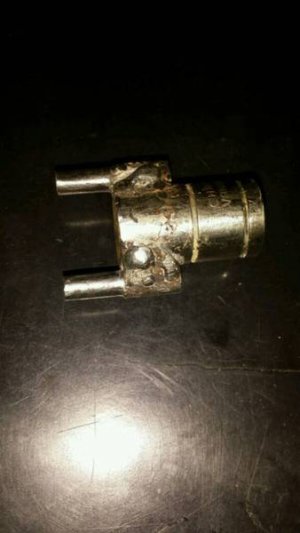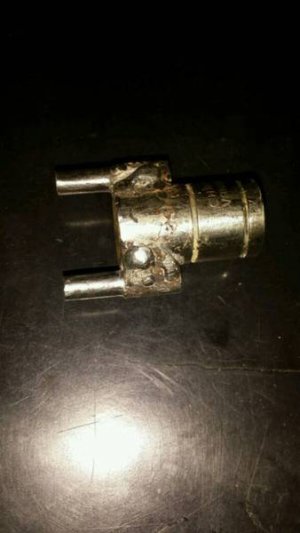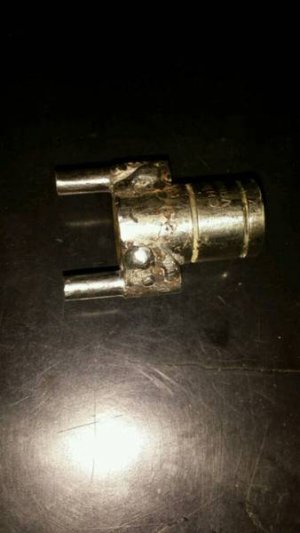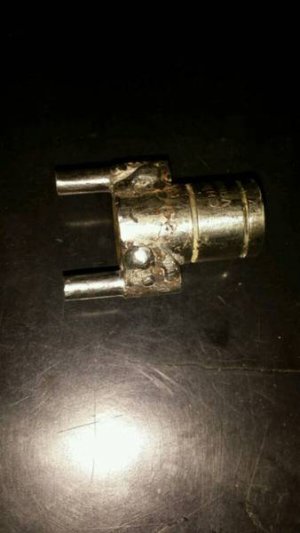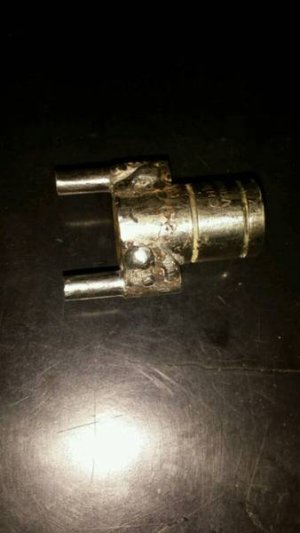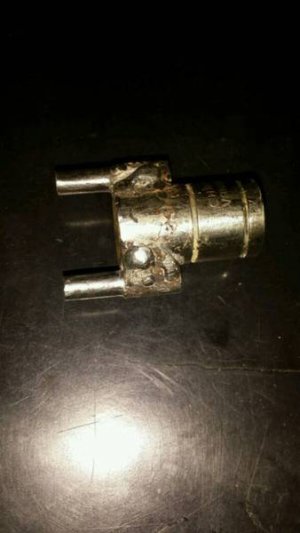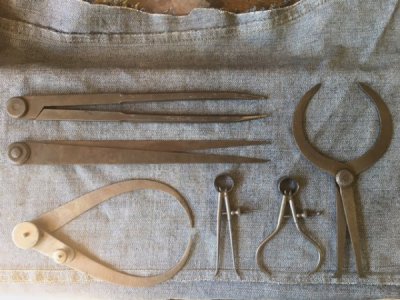-
Welcome back Guest! Did you know you can mentor other members here at H-M? If not, please check out our Relaunch of Hobby Machinist Mentoring Program!
- Forums
- THE PROJECTS AREA
- PROJECT OF THE DAY --- WHAT DID YOU DO IN YOUR SHOP TODAY?
- Project of the Day Mega-Thread Archives
You are using an out of date browser. It may not display this or other websites correctly.
You should upgrade or use an alternative browser.
You should upgrade or use an alternative browser.
2016 POTD Thread Archive
- Thread starter sanddan
- Start date
Here's the finished exhaust I made yesterday, attached to the replacement motor I got today:
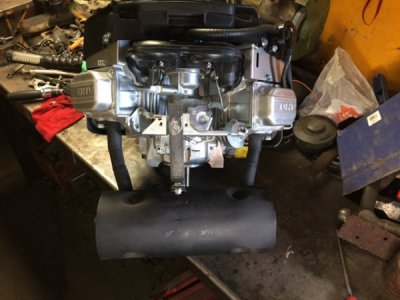
This motor, thankfully, doesn't drip oil while running [from googling, it seems it is common for B&S motors to leak along the joint where the two halves of the crankcase meet, the old motor probably didn't get the gasket installed quite right].
It turned out that the motor failing now resulted in me finding that the post that holds the clutch for engaging the blades in place was about 95% worn through [the clutch rotates back and forth a bit when you engage/disengage the blades, and it bangs against this post every time]. If it had completely worn through, the clutch would have just rotated with the engine, ripping the wiring harness apart. I was able to fill the worn away area with weld, and then ground it down to the original square shape. I'll have to keep an eye on it for the next while to make sure the welding holds [I haven't done enough welding to really trust it], as well as the exhaust to make sure the welds don't crack.

This motor, thankfully, doesn't drip oil while running [from googling, it seems it is common for B&S motors to leak along the joint where the two halves of the crankcase meet, the old motor probably didn't get the gasket installed quite right].
It turned out that the motor failing now resulted in me finding that the post that holds the clutch for engaging the blades in place was about 95% worn through [the clutch rotates back and forth a bit when you engage/disengage the blades, and it bangs against this post every time]. If it had completely worn through, the clutch would have just rotated with the engine, ripping the wiring harness apart. I was able to fill the worn away area with weld, and then ground it down to the original square shape. I'll have to keep an eye on it for the next while to make sure the welding holds [I haven't done enough welding to really trust it], as well as the exhaust to make sure the welds don't crack.
- Joined
- Feb 17, 2013
- Messages
- 4,407
Mark, be careful! Everything I've heard about metric threading on a lathe with an inch leadscrew (including recent posts by dave_r_1 and savarin) has always said not to disengage the half nuts at all!... I learned the hard way, the gears work great, but when metric threading, you MUST ALWAYS ENGAGE THE HALF NUTS ON THE SAME MARK ON THE THREAD DIAL. If you start on number one, you must start every pass on that number. Using any other line or number will split the threads.
Think of it this way ... adding a 127/120 gear ratio, with 127 being a prime number, means you'd probably have to rotate the spindle 127 turns before you could hope to get back "in sync."
I don't recall what model lathe you have (or what write-up you're referring to), but the manuals for both of my Grizzlies (G4000 and G4002) mention not disengaging the half nuts. However, the warning is NOT in the section devoted to metric threading. It's further on, in the section on the threading dial.By the way..... it says NOWHERE in the write up for this metric threading about that detail. I think it was kind of important to be left out of the write up.
Meanwhile, my condolences for the fact that your "learning curve" came with such a high tuition cost
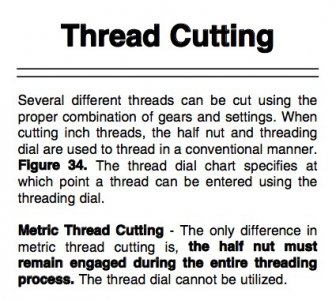
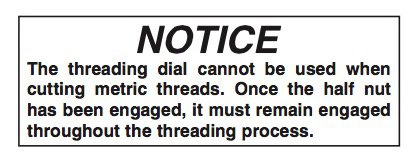
- Joined
- Jun 26, 2014
- Messages
- 619
Also picked up a non-functioning treadmill for R300 (about US$20) to salvage the motor for a future yet to be determined project. Too good of a price to turn down.
But silly me had to have a play and prove I could get it working again, and now the family want to keep it !
Well I figure they will have probably worn sick of it by the time I figure out what I'm going to use the motor for anyway so no harm.
But silly me had to have a play and prove I could get it working again, and now the family want to keep it !
Well I figure they will have probably worn sick of it by the time I figure out what I'm going to use the motor for anyway so no harm.
B
British Steel
Forum Guest
Register Today
99% of my threads are metric, I just leave the half nuts engaged and reverse back
Same, the only Imperial threads I come across are on vintage(ish) British bike parts, Hardley-Ridables and machine tools old enough for me to afford...
It helps that I can select high or low speeds (about a 4.5:1 ratio) with my lathe's clutch/brake box for reversing out, speeds things up a lot, and it has a retracting lever on the cross-slide to pull the tool out, so no worries with bringing a handwheel back to zero each time.
I THINK I read somewhere that you can disengage the leadscrew nuts in a couple of situations, the one that made sense was if you had a "backstop" for the carriage to crank it back to and so you can always engage the same number in *exactly* the same position along the ways - this makes sense because (I think) you'd be dropping into the same relationship between spindle and leadscrew - but it might take a while for the number to come up?
The other method I read (but also haven't tried) was to disengage on a number, then reverse back to the same number to engage - this is much the same as leaving the half-nuts closed but lets you stop in a runout groove more easily (I suspect the runout groove would need to be cut at the point where the number aligned though?).
Or there's the single-tooth clutch running at spindle speed, in the reversing gearing, as on a lot of toolroom lathes... That's pretty much the same method as disengage / reengage on the same number, but the clutch does the hard bit!
Dave H. (the other one)
- Joined
- Nov 23, 2014
- Messages
- 2,610
Hi Mark,Well ..... I did something stupid today. I tried out my new transposing gears for metric threading on my South bend lathe.....BUT.....I tried them out on the almost finished collet chuck I made. The metric threads were the last step. I SCREWED IT UP! ( I should have experimented on a sample part)... I learned the hard way, the gears work great, but when metric threading, you MUST ALWAYS ENGAGE THE HALF NUTS ON THE SAME MARK ON THE THREAD DIAL. If you start on number one, you must start every pass on that number. Using any other line or number will split the threads. I finally figured that out and got a good thread but it was too small by this time and the nut is a little too loose for my taste.. So... I made another collet chuck and will finish it up tomorrow.
By the way..... it says NOWHERE in the write up for this metric threading about that detail. I think it was kind of important to be left out of the write up.
Sorry to hear about that, probably a Murphy's law variation about the new to you machining operation always falls on the last step of making the part.
My Grizzly G0709 manual mentions that when cutting metric threads, once you engage the half nuts you do not disengage them until the threading is complete. Apparently even hitting the same number on the thread dial doesn't guarantee not splitting the thread. Kind of a pain to stop short, turn the chuck by hand to finish the thread. Then try to remember to NOT disengage the half nuts and move the carriage back to the starting point. Reversing the lathe with the half nuts engaged to back up the carriage isn't my normal method of threading. Good luck on the next one!
Bruce
- Joined
- Mar 25, 2013
- Messages
- 4,643
So just to clarify: For metric threading, must one leave the half nut engaged or can you just hit the same number on the thread dial? When threading to a shoulder, leaving the nut engaged is dangerous on my machine. Does anyone know the answer definitively?
R
R


